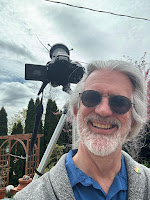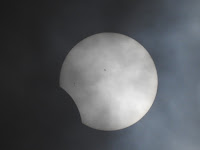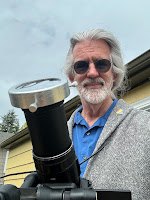Today I managed to site today’s total solar eclipse. Oregon was outside the path of totality, and Eugene only got about 23.5% sun coverage. I thought this eclipse would be a little like last year’s, which was not very visible through the clouds, but the morning was relatively sunny before the eclipse, so I readied my colander, camera, and tripod with high (or at least higher) hopes.
I set up my portable work desk on the back deck and set things up. I put a solar filter over the lens of my camera. Back in the summer when I bought it, I had a notion that I’d fly east to be in the path of totality. But by the time I got my act together in mid-January and sat down to actually purchase a ticket, they were prohibitively expensive. The filter allows me to get a close-up of the sun’s disk, complete with sunspots.
When the eclipse started, there was a light haze. As the eclipse progressed over the next hour or so, the clouds became thicker. This presented a bit of a challenge, as I had to keep adjusting the exposure time to compensate for changes in the sun’s luminosity. When the cloud cover thickened, I used a longer exposure time; when I used a longer exposure time, the camera was more likely to pick up the scattered light from the clouds. Also, I’m also thinking the filter messed up the sharpness of focus—although I sometimes have difficulty dialing in sharpness of the moon’s features when I’ve extended the lens barrel out all the way.
Between shots I took a look at the sun through some eclipse glasses. I also tried to get a good image of the eclipse through the holes of a colander; I think it would have worked better with more of the sun covered by the moon and less covered by the haze and clouds.
This eclipse was fun, and I remember the eclipse of Friday, August 5, 2017. That eclipse was a party with eggs, bacon, and mimosas. This eclipse was juggled between a kind of early lunch, and various Day Jobbe tasks. The previous eclipse was a family event; this year it was just me (Mark went into work), the dog, and the cats (Aoife did lunge into the camera tripod near the end to harass squirrels). The effects of the eclipse were muted by the clouds, and we weren’t in the path of totality, so there were no amber alerts, shadow bands, or roosting birds.
Shortly after maximum coverage, the clouds thickened and hid most of the rest of the eclipse. I did get a few shots in at the end when the sky cleared some. Of course, as soon as the eclipse was complete, the clouds cleared up and the sky was a deep, clear blue.
Still, it was better than last year’s annular eclipse.









No comments:
Post a Comment